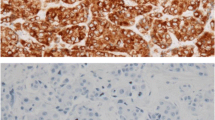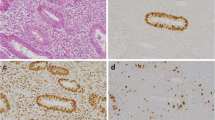Abstract
To clarify the relation betweenbcl-2 protein (Bcl-2) expression and p53 alteration during progression of endometrial carcinomas (endometrioid type), 92 consecutive hysterectomy specimens were examined by immunohistochemistry. Loss of heterozygosity (LOH) for thep53 gene was also examined using the polymerase chain reaction(PCR)-LOH assay. Moderate to strong Bcl-2 immunointensity in more than 30% of cells was found in 32 (34.8%) of 92 carcinomas, with a clear link to favorable clinicopathological features, such as a high differentiation grade (P=0.0084), an early stage (P=0.0432) and limited invasion into the myometrium (P=0.0084). In contrast, positive results for p53 immunohistochemistry (more than 30% positive cells) or PCR-LOH analysis were revealed in 16 (17.4%) of 92 and 18 (22.5%) of 80 tumors respectively. Although there was no apparent association between the nuclear p53 staining and the presence of LOH, the lack of correlation being observed in 23 (28.7%) of the tumors, both alterations were significantly linked with several unfavorable prognostic factors. In addition, an inverse correlation was observed between Bcl-2 expression and p53 protein accumulation (P=0.0084). These data suggest that, in endometrial carcinomas, Bcl-2 and p53 alterations may play important roles in determining whether tumor progression from early to advanced stages will occur.
Similar content being viewed by others
References
Baas IO, Mulder J-WR, Offerhaus JA, Vogelstein B, Hamilton SR (1994) An evaluation of six antibodies for immunohistochemistry of mutant p53 gene product in archival colorectal neoplasms. J Pathol 172:5–12
Berchuck A, Boyd J (1995) Molecular basis of endometrial cancer. Cancer 76:2034–2040
Borresen AL, Hovig E, Smith-Sorensen B, Malkin D, Lystsd S, Andersen TI, Nesland JM, Isselbacher KJ, Friend SH (1991) Constant denaturant gel electrophoresis as a rapid screening technique for p53 mutations. Proc Natl Acad Sci USA 88:8405–8409
Calle-Martin O DE LA, Fabregat V, Romero M, Soler J, Vives J, Yague J (1990) Acc II polymorphism of the p53 gene. Nucleic Acids Res 18:4963
Castle VP, Heidelberger KP, Bromberg J, Ou X, Dole M, Nunez G (1993) Expression of the apoptosis-suppressing protein Bcl-2 in neuroblastoma is associated with unfavorable history and N-myc amplification. Am J Pathol 143:1543–1550
Chan WK, Mole MM, Levison DA, Ball RY, Lu Q-L, Pate K, HanbyA AM (1995) Nuclear and cytoplasmic bcl-2 expression in endometrial hyperplasia and adenocarcinoma. J Pathol 177:241–246
Creasman WT (1989) Announcement. FIGO stages: 1988 revisions. Gynecol Oncol 35:125–127
Creasman WT (1993) Prognostic significance of hormone receptors in endometrial cancer. Cancer 71:1467–1470
Davidoff AM, Humphrey PA, Iglehart JD, Marks JR (1991) Genetic basis for p53 overexpression in human breast cancer. Proc Natl Acad Sci USA 88:5006–5010
Eccles DM, Russell SEH, Haites N, The ABE Ovarian Cancer Genetics Group (1992) Early loss of heterozygosity on 17q in ovarian cancer. Oncogene 7:2069–2072
Ehrlich CE, Young PCM, Stehman FB, Sutton GP, Alford WM (1988) Steroid receptors and clinical outcome in patients with adenocarcinoma of the endometrium. Am J Obstet Gynecol 158:796–807
Foulkes WD, Black DM, Stamp GWH, Solomon E, Trowsdale J (1993) Very frequent loss of heterozygosity throughout chromosome 17 in sporadic ovarian carcinoma. Int J Cancer 54:220–225
Goelz SE, Hamilton SR, Vogeltein B (1985) Purification of DNA from formaldehyde fixed and paraffin embedded human tissue. Biochem Biophys Res Commun 130:118–126
Hahn M, Serth J, Fislage R, Wolfes H, Allhoff E, Jonas U, Pingoud A (1993) Polymorphic VNTR segment in intron 1 of the human p53 gene. Clin Chem 39:549–550
Haldar S, Negrini M, Monne M, Sabbioni S, Croce CM (1994) Down-regulation of bcl-2 by p53 in breast cancer cells. Cancer Res 54:2095–2097
Imamura T, Arima T, Kato H, Miyamoto S, Sasazuki T, Wake N (1992) Chromosomal deletions and K-ras gene mutations in human endometrial carcinomas. Int J Cancer 51:47–52
Ito K, Watanabe K, Nasim S, SasanoA H, Sato S, Yajima A, Silverberg SG, Garrett CT (1994) Prognostic significance of p53 overexpression in endometrial cancer. Cancer Res 54:4667–4670
Joensuu H, Phylkkanen L, Toikkanen S (1994) Bcl-2 protein expression and long-term survival in breast cancer. Am J Pathol 145:1191–1198
Jones MH, Nakamura Y (1992) Detection of loss of heterozygosity at the human TP53 locus using a dinucleotide repeat polymorphism. Genes Chromosomes Cancer 5:89–90
Kauppila AJI, Isotalo HE, Kivinen ST, Vihko RK (1986) Prediction of clinical outcome with estrogen and progestin receptor concentrations and their relationships to clinical and histopathological variables in endometrial cancer. Cancer Res 46:5380–5384
Kernohan NM, Cox LS (1996) Regulation of apoptosis by Bcl-2 and its related proteins: immunochemical challenges and therapeutic implications. J Pathol 179:1–3
Kim CJ, Kim WH, Kim CW, Lee JB, Lee CK, Kim YI (1995) Detection of 17p loss in gastric carcinoma using polymerase chain reaction. Lab Invest 72:232–236
Knudson AG Jr (1971) Mutation and cancer: statistical study of retinoblastomas. Proc Natl Acad Sci USA 68:820–823
Kohler MF, Berchuck A, Davidoff AM, Humphrey PA, Dodge RK, Iglehart JD, Soper JT, Clarke-Person DL, Bast RC Jr, Marks JR (1992) Overexpression and mutation of p53 in endometrial carcinoma. Cancer Res 52:1622–1627
Levine AJ, Momand J, Finlay CA (1991) The p53 tumour suppressor gene. Nature 351:453–456
Lipponen P, Pietilainen T, Kosma V-M, Aaltomaa S, Eskelinen M, Syrjanen K (1995) Apoptosis suppressing protein bcl-2 is expressed in well-differentiated breast carcinomas with favourable prognosis. J Pathol 177:49–55
Lu Q-L, Abel P, Foster CS, Lalani E-N (1996) bcl-2: role in epithelial differentiation and oncogenesis. Hum Pathol 27:102–110
Marks JR, Davidoff AM, Kerns BJ, Humphrey PA Pence JC, Dodge RK, Clarke-Pearson DL, Iglehart JD, Bast RC Jr, Berchuck A (1991) Overexpression and mutation of p53 in epithelial ovarian cancer. Cancer Res 51:2979–2984
McDonnell TJ, Korysmeyer SJ (1991) Progression from lymphoid hyperplasia to high-grade malignant lymphoma in mice transgenic for the t(14;18). Nature 349:254–256
McDonnell TJ, Troncoso P, Brisbay SM, Logothetis C, Chung LWK, Hsieh J-T, Tu SM, Campbell ML (1992) Expression of the protooncogene bcl-2 in the prostate and its association with emergence of androgen-independent prostate cancer. Cancer Res 52:6940–6944
McManus DT, Yap EPH, Maxwell P, Russell SEH, Toner PG, McGee JO'D (1994) p53 expression, mutation, and allelic deletion in ovarian cancer. J Pathol 174:159–168
McManus DT, Murphy M, Hamilton PW, Russell SEH, Toner PG (1996) p53 mutation, allele loss on chromosome 17p, and DNA content in ovarian carcinoma. J Pathol 179:177–182
Midgley J, Vojtesek B, Lane DP, Barnes DM (1992) Analysis of p53 expression in human tumours: an antibody raised against human p53 expressed inE. coli. J Cell Sci 101:183–189
Nakamura S, Akazawa K, Kinukawa N, Yao T, Tsuneyoshi M (1996) Inverse correlation between the expression of bcl-2 and p53 proteins in primary gastric lymphoma. Hum Pathol 27:225–233
Okamoto A, Sameshima Y, Yamada Y, Teshima S, Terashima Y, Terada M, Yokota J (1991) Allelic loss on chromosome 17p and p53 mutations in human endometrial carcinoma of the uterus. Cancer Res 51:5632–5636
Okayasu I, Saegusa M, Fujiwara M, Hara Y, Rose NR (1995) Enhanced cellular proliferative activity and cell death in chronic thyroiditis and thyroid papillary carcinoma. J Cancer Res Clin Oncol 121:746–752
Pezzella F, Turley H, Kuzu I, Tungekar MF, Dunnill MS, Pierce CB, Harris A, Gatter KC, Mason DJ (1993) Bcl-2 protein in non-small-cell lung carcinoma. N Engl J Med 329:690–694
Pilotti S, Collini P, Rilke F, Cattoretti G, Bo RD, Pierottima (1994) Bcl-2 protein expression in carcinomas originating from the follicular epithelium of the thyroid gland. J Pathol 172:337–342
Saegusa M, Takano Y, Hashimura M, Shoji Y, Okayasu I (1995a) The possible role of bcl-2 expression in the progression of tumors of the uterine cervix. Cancer 76:2297–2303
Saegusa M, Takano Y, Okayasu I (1995b) Bcl-2 expression and its association with cell kinetics in human gastric carcinomas and intestinal metaplasia. J Cancer Res Clin Oncol 121:357–363
Saegusa M, Kamata Y, Isono M, Okayasu I (1996a) Bcl-2 expression is correlated with a low apoptotic index and associated with progesterone receptor immunoreactivity in endometrial carcinomas. J. Pathol 180:275–282
Saegusa M, Takano Y, Kamata Y, Okayasu I (1996b) Bcl-2 expression and allelic loss of the p53 gene in gastric carcinomas. J Cancer Res Clin Oncol 122:427–432
Soong R, Robbins PD, Dix BR, Grieu F, Lim B, Knowles S, Williams KE, Turbett GR, House AK, Iacopetta BJ (1996a) Concordance between p53 protein overexpression and gene mutation in a large series of common human carcinomas. Hum Pathol 27:1050–1055
Soong R, Knowles S, Williams KE, Hammondig, Wysocki, Iacopetta BJ (1996b) Overexpression of p53 protein is an independent prognostic indicator in human endometrial carcinoma. Br J Cancer 74:562–567
Uesugi, Saegusa M, Takano Y, Okayasu I (1996) Different expression of Bcl-2 protein in gastric adenomas and carcinomas. Pathol Int 46:274–280
Viale G, Roncalli M, Grimelius L, Graziani D, Wilander E, Johansson H, Bergholm U, Coggi G (1995) Prognostic value of Bcl-2 immunoreactivity in medullary thyroid carcinoma. Hum Pathol 26:945–950
Vogelstein B, Kinzler KW (1992) p53 function and dysfunction. Cell 70:523–526
Author information
Authors and Affiliations
Rights and permissions
About this article
Cite this article
Saegusa, M., Okayasu, I. Bcl-2 is closely correlated with favorable prognostic factors and inversely associated with p53 protein accumulation in endometrial carcinomas: immunohistochemical and polymerase chain reaction/loss of heterozygosity findings. J Cancer Res Clin Oncol 123, 429–434 (1997). https://doi.org/10.1007/BF01372546
Received:
Accepted:
Issue Date:
DOI: https://doi.org/10.1007/BF01372546




